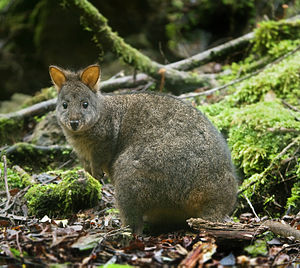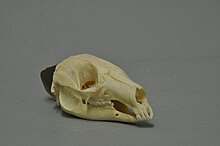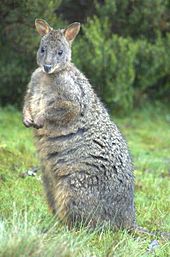Red-bellied filander
| Red-bellied filander | ||||||||||||
|---|---|---|---|---|---|---|---|---|---|---|---|---|

Red-bellied filander ( Thylogale billardierii ) |
||||||||||||
| Systematics | ||||||||||||
|
||||||||||||
| Scientific name | ||||||||||||
| Thylogale billardierii | ||||||||||||
| ( Desmarest , 1822) |
The red-bellied filander ( Thylogale billardierii ) is a species of kangaroo from the genus Filander ( Thylogale ).
features

Red-bellied filanders are relatively small representatives of the kangaroos, the males weigh about seven kilograms, the females four kilograms. Their physique is stocky, the sparsely hairy tail is relatively short. Their long fur is gray-brown on the upper side, the underside is reddish-orange. As with most kangaroos, the back legs are longer and stronger than the front legs.
distribution and habitat
Originally, red-bellied filanders inhabited southeastern Australia and lived in southeastern South Australia , Victoria and Tasmania . On the mainland, however, they became extinct at the beginning of the 20th century, so that today they only occur in Tasmania, where they are however common. Their habitat are forests and bushlands with dense vegetation.
Lifestyle and diet
These kangaroos are predominantly nocturnal, during the day they sleep hidden in dense vegetation. At night they go in search of food, covering up to two kilometers to get from the sleeping place to the feeding place. To get ahead faster, they create trails through the dense undergrowth. When foraging for food they form groups of up to 10 animals, but there is no evidence that these groups develop a permanent structure. Their diet consists mainly of grasses and herbs. When feeding, they always stay close to the protective vegetation and return there immediately if there are signs of danger.
Reproduction
After a gestation period of around 30 days, the female usually gives birth to a single young. Most births fall between April and June. As with many kangaroos, delayed birth can be observed in them . The newborn spends its first 200 days in the mother's pouch and is finally weaned after another four months. Sexual maturity occurs at around 14 to 15 months. In the wild, their life expectancy is around five to six years.
Danger
The populations of the red-bellied filander on the Australian mainland died out at the beginning of the 20th century, at the latest by 1920. The main reason for this was the stalking by the introduced foxes . In Tasmania, however, the species is so common that it is considered a plague in some places and may be hunted. The IUCN lists the species as not endangered.
The species is no longer maintained in Europe, the former owners are Kronberg, Frankfurt, Berlin and Augsburg.
supporting documents
literature
- Ronald M. Nowak: Walker's Mammals of the World. 6th edition. Johns Hopkins University Press, Baltimore 1999, ISBN 0-8018-5789-9 .
- Randolph W Rose; Robert K Rose: Thylogale billardierii (Diprotodontia: Macropodidae). Mammalian Species 50 (965) on Sep 25, 2018; Pp. 100-108. doi : 10.1093 / mspecies / sey012
Web links
- Information at Animal Diversity Web
- Thylogale billardierii onthe IUCN Red List of Endangered Species . Retrieved May 18, 2009.

